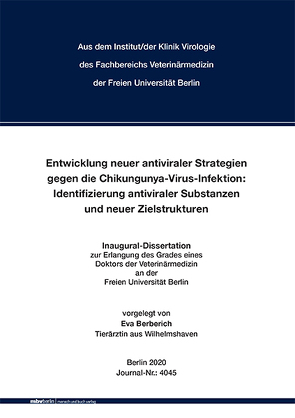
Development of novel antiviral strategies against a Chikungunyavirus-infection: Identification of antiviral substances and novel targets
The Chikungunyavirus (CHIKV) is a mosquito-transmitted Alphavirus that causes chikungunya fever, with flu like symptoms, in humans. However severe arthritis may persist for several years after an infection in 30 % of the infected persons, which might lead to considerable economic costs during large outbreaks. CHIKV was first documented in Tanzania in 1952 and then spread in Africa, to Asia and currently to South America including the Caribbean islands. Temperate and cold regions are reachable due to an effectively adaptation to the Asian tiger mosquitos, globalization and climate warming. There is no specific treatment or licensed vaccine for chikungunya fever, making it important to find an effective means preventing or combating a chikungunya infection. CHIKV is a (+)-single stranded-RNA virus which enters cells by receptor-mediated endocytosis and a subsequent pH-dependent fusion step. CHIKV has two surface proteins, which are involved in the entryprocess. The glycoprotein E1 is a class II viral fusion protein, E2 mediates cell attachment and is further divided into three subdomains A, B and C. The domains are linked to each other via a ß-ribbon-connector, which contains an acid-sensitive region. The focus is on finding strategies to prevent the entry of CHIKV into human cells, by characterizing the function of the E2 protein in more detail. Additionally the important role of cell surface glycosaminoglycans (GAGs) for CHIKV cell attachment was studied. Previous work could show that cell surface GAGs promote CHIKV entry. Mutations in E2 domain A from cell culture adapted CHIKV further enhanced CHIKV binding to GAG expressing cells. Therefore Fc-E2-fusion proteins, consisting of the Fc-region of a human antibody and subdomains of the glycoprotein E2, as well as fusion proteins with mutations in the subdomain A, which are described above, were generated. Furthermore Fc-E2-fusion proteins were created, which lack the ß-ribbon-connector or contain only the β-ribbon-connector, to prove its role in the cell binding process. It could be shown, that subdomain C is without any binding ability. Subdomain A binds just in combination with the β-ribbon-connector to both cell types. The binding affinity to GAG expressing cells is much higher. Subdomain B in combination with the β-ribbon-connector showed a significant binding to GAG expressing cells, but the domain lacking the β-ribbon-connector could still weakly bind to both cell types. That implicates that the β-ribbon-connector of the CHIKV E2 protein regulates the GAG-dependent cell entry. Additionally domain B seems to be involved in the entry mechanism as well. Due to the mutation of the β-ribbon-connector at the position 166, which provided a positive charge displacement, the combination of domain A and mutated β-ribbon-connector had an increased binding activity on GAG-expressing cells. This generated fusion protein binds on GAG-deficient cells as well, although less than on GAG-expressing cells. Furthermore it could be ascertained that the N-glycosylation at the position 263 (β-ribbon-connector) has an inhibiting function on the cell binding. In summary the ß-ribbon-connector could be identified as the main binding structure of the CHIKV E2 glycoprotein and therefore it is a good candidate for antiviral drug development.
Aktualisiert: 2021-08-19
> findR *
MEHR ANZEIGEN
Bücher zum Thema glycosaminoglycans
Sie suchen ein Buch über glycosaminoglycans? Bei Buch findr finden Sie eine große Auswahl Bücher zum
Thema glycosaminoglycans. Entdecken Sie neue Bücher oder Klassiker für Sie selbst oder zum Verschenken. Buch findr
hat zahlreiche Bücher zum Thema glycosaminoglycans im Sortiment. Nehmen Sie sich Zeit zum Stöbern und finden Sie das
passende Buch für Ihr Lesevergnügen. Stöbern Sie durch unser Angebot und finden Sie aus unserer großen Auswahl das
Buch, das Ihnen zusagt. Bei Buch findr finden Sie Romane, Ratgeber, wissenschaftliche und populärwissenschaftliche
Bücher uvm. Bestellen Sie Ihr Buch zum Thema glycosaminoglycans einfach online und lassen Sie es sich bequem nach
Hause schicken. Wir wünschen Ihnen schöne und entspannte Lesemomente mit Ihrem Buch.
glycosaminoglycans - Große Auswahl Bücher bei Buch findr
Bei uns finden Sie Bücher beliebter Autoren, Neuerscheinungen, Bestseller genauso wie alte Schätze. Bücher zum
Thema glycosaminoglycans, die Ihre Fantasie anregen und Bücher, die Sie weiterbilden und Ihnen wissenschaftliche
Fakten vermitteln. Ganz nach Ihrem Geschmack ist das passende Buch für Sie dabei. Finden Sie eine große Auswahl
Bücher verschiedenster Genres, Verlage, Autoren bei Buchfindr:
Sie haben viele Möglichkeiten bei Buch findr die passenden Bücher für Ihr Lesevergnügen zu entdecken. Nutzen Sie
unsere Suchfunktionen, um zu stöbern und für Sie interessante Bücher in den unterschiedlichen Genres und Kategorien
zu finden. Unter glycosaminoglycans und weitere Themen und Kategorien finden Sie schnell und einfach eine Auflistung
thematisch passender Bücher. Probieren Sie es aus, legen Sie jetzt los! Ihrem Lesevergnügen steht nichts im Wege.
Nutzen Sie die Vorteile Ihre Bücher online zu kaufen und bekommen Sie die bestellten Bücher schnell und bequem
zugestellt. Nehmen Sie sich die Zeit, online die Bücher Ihrer Wahl anzulesen, Buchempfehlungen und Rezensionen zu
studieren, Informationen zu Autoren zu lesen. Viel Spaß beim Lesen wünscht Ihnen das Team von Buchfindr.
